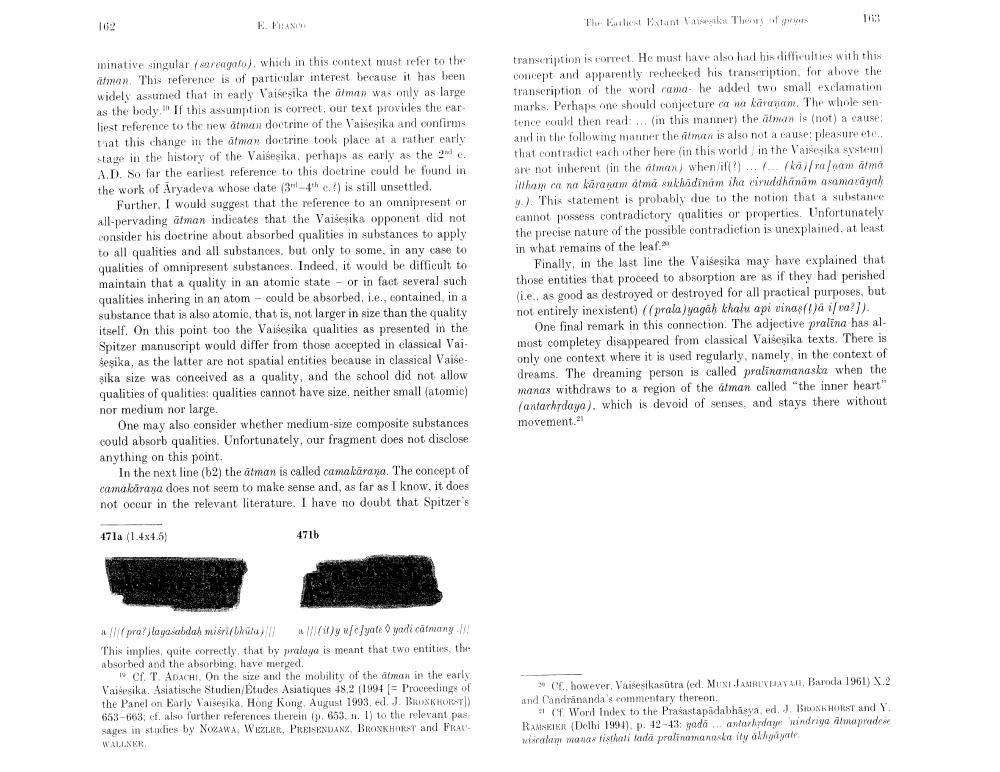Book Title: Earliest Extant Vaisesika Theory Of Gunas Author(s): Eli Franco Publisher: Eli Franco View full book textPage 5
________________ 162 E. FRANCO The Earliest Extant Vaisesika Theory of goas 163 minative singular (sarvagato), which in this context must refer to the atman. This reference is of particular interest because it has been widely assumed that in early Vaisesika the atman was only as large as the body.'' If this assumption is correct, our text provides the earliest reference to the new atman doctrine of the Vaisesika and confirms that this change in the atman doctrine took place at a rather early stage in the history of the Vaisesika, perhaps as early as the 2nd c. A.D. So far the earliest reference to this doctrine could be found in the work of Aryadeva whose date (3r-4th c.?) is still unsettled. Further, I would suggest that the reference to an omnipresent or all-pervading atman indicates that the Vaisesika opponent did not consider his doctrine about absorbed qualities in substances to apply to all qualities and all substances, but only to some, in any case to qualities of omnipresent substances. Indeed, it would be difficult to maintain that a quality in an atomic state - or in fact several such qualities inhering in an atom - could be absorbed, i.e., contained, in a substance that is also atomic, that is, not larger in size than the quality itself. On this point too the Vaisesika qualities as presented in the Spitzer manuscript would differ from those accepted in classical Vaisesika, as the latter are not spatial entities because in classical Vaisesika size was conceived as a quality, and the school did not allow qualities of qualities: qualities cannot have size, neither small (atomic) nor medium nor large. One may also consider whether medium-size composite substances could absorb qualities. Unfortunately, our fragment does not disclose anything on this point. In the next line (b2) the atman is called camakarana. The concept of camakarana does not seem to make sense and, as far as I know, it does not occur in the relevant literature. I have no doubt that Spitzer's transcription is correct. He must have also had his difficulties with this concept and apparently rechecked his transcription, for above the transcription of the word cama- he added two small exclamation marks. Perhaps one should conjecture ca na karanam. The whole sentence could then read: ... (in this manner) the atman is (not) a cause; and in the following manner the atman is also not a cause: pleasure etc.. that contradict each other here in this world / in the Vaisesika system) are not inherent (in the atman) when/if(?) ... (... (ka) [ra]nam atma ittham ca na karanam atma sukhadinam iha viruddhanam asamavayah y.). This statement is probably due to the notion that a substance cannot possess contradictory qualities or properties. Unfortunately the precise nature of the possible contradiction is unexplained, at least in what remains of the leaf.21 Finally, in the last line the Vaisesika may have explained that those entities that proceed to absorption are as if they had perished (i.e., as good as destroyed or destroyed for all practical purposes, but not entirely inexistent) ((prala) yagah khalu api vinas(t)a i[va?)). One final remark in this connection. The adjective pralina has almost completey disappeared from classical Vaisesika texts. There is only one context where it is used regularly, namely, in the context of dreams. The dreaming person is called pralinamanaska when the manas withdraws to a region of the atman called "the inner heart" (antarhrdaya), which is devoid of senses, and stays there without movement.21 471a (1.4x4.5) 471b a ///(pra?)layasabdah misri(bhuta)!ll a lll(it)y u[C]yate o yadi catmany. /// This implies, quite correctly, that by pralaya is meant that two entities, the absorbed and the absorbing, have merged. 19 Cf. T. ADACHI, On the size and the mobility of the atman in the early Vaisesika. Asiatische Studien/Etudes Asiatiques 48,2 (1994 (= Proceedings of the Panel on Early Vaisesika, Hong Kong, August 1993, ed. J. BRONKHORST) 653-663; cf. also further references therein (p. 653, n. 1) to the relevant pas sages in studies by NOZAWA, WEZLER, PREISENDANZ, BRONKHORST and FRALWALLNER 20 Cf., however, Vaisesikasutra (ed. MUNI JAMBUVIJAYAJI. Baroda 1961) X.2 and Candrananda's commentary thereon. 21 Cf. Word Index to the Prasastapadabhasva, ed. J. BRONKHORST and Y. RAMSELER (Delhi 1994), p. 42-43: yada ... antarhrdaye nindriya atmapradese miscalam manas tisthati tada pralinamanaska ity akhyayate.Page Navigation
1 ... 3 4 5
